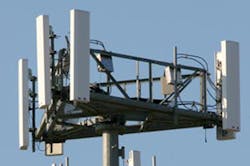Antennas and eICIC Testing Boost Mobile And HetNet Performance Levels
Mobile-handset manufacturers have been seeking an antenna design that is suitable for the latest fourth-generation (4G) Long-Term-Evolution (LTE) cellular handsets. Their goal is to achieve desired antenna performance in a size small enough for modern cellular handsets. They need to reach that end at an acceptable high-volume cost that does not impact handset price. A solution may have emerged in a single-antenna technology, which will enable smartphone and tablet device manufacturers to replace several antennas with one multiband component. This solution has been developed by UK company Smart Antenna Technologies (SAT), a spinout from the University of Birmingham, England.
At present, mobile devices use multiple antennas for different communications technologies, such as Bluetooth, WiFi, GPS, GSM, and 3G/4G. Phones with 4G capability can have as many as six narrowband antennas operating on individual band segments. In addition to escalating the overall cost of mobile-device design, the need for multiple antennas consumes a lot of space within the product.The SAT solution, in contrast, uses a foil or printable antenna and control chip to produce a compact, multi-frequency antenna. The design was created by radio antenna expert Professor Peter Hall and his team at the University of Birmingham.
Significant cost savings are envisioned with this design. Each antenna is predicted to cost $2, which is a considerable savings over the current estimate of $20 per handset for today’s multi-antenna solutions. Notably, the SAT antenna design also uses software-reconfigurable hardware, which will allow mobile manufacturers to apply one device for all territories and communications technologies. According to the company, its single-antenna design is complementary to existing RF solutions being used by the mobile-phone industry and emerging products, such as Qualcomm’s RF360 technology.
The SAT team has been working with venture capital company Mercia Fund Management to secure its first investment—a Seed Enterprise Investment Scheme round. In addition, it will soon be completing a further syndicated round lead by Mercia. Funding will be used to produce the first product and deploy to customers.
Everard Mascarenhas, Co-Founder of Mercia Fund Management, comments: “Currently, 1.2 billion phones are manufactured each year. SAT’s technology has the potential to deliver a 10% to 20% reduction in the bill of materials for each of these products. It is one of the very few technologies that ticks all the boxes for mobile-phone manufacturers, and it is not surprising that it is generating so much interest from handset manufacturers. Together with SAT management, we have taken world-class research from the University of Birmingham and created a company with a truly disruptive solution for smartphones and tablets, which represent one of the fastest-growing sectors in consumer electronics.”
About the Author
Paul Whytock
Editor-in-Chief
Paul Whytock is European Editor for Microwaves & RF and European Editor-in-Chief for Electronic Design. He reports on the latest news and technology developments in Europe for his US readers while providing his European engineering audience with global news coverage from the electronics sector. Trained originally as a design engineer with Ford Motor Co., Whytock holds an HNC in mechanical, electrical, and production engineering.
